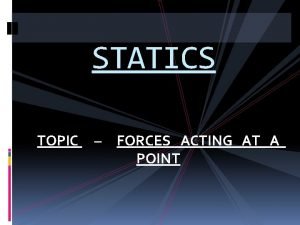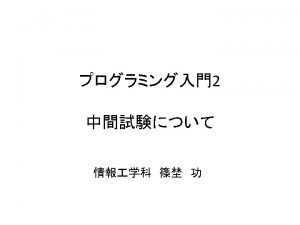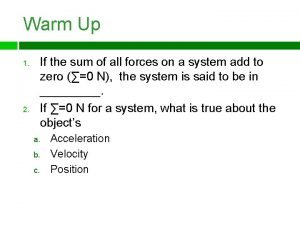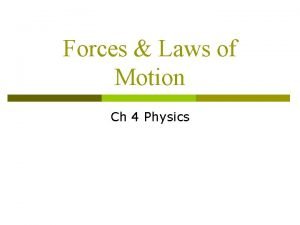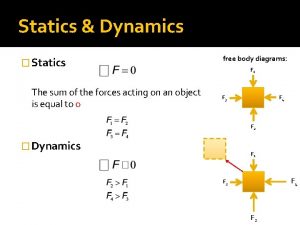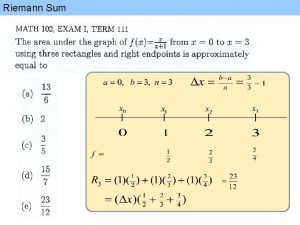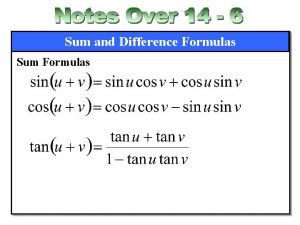Statics Dynamics Statics The sum of the forces






- Slides: 6

Statics & Dynamics � Statics The sum of the forces acting on an object is equal to o free body diagrams: F 1 F 3 F 4 F 2 � Dynamics F 1 F 4 F 3 F 2

Rocket! � Newton’s second law of motion: force mass acceleration We know that the forces acting on our rockets are: weight exhaust velocity W gravity (a =9. 8 m/s 2) rate of mass ejection (Δ fuel mass/Δ time) Another force to take into account is the force due to air friction; we will assume it is negligible Fthrust

Energy � First law of thermodynamics: Energy is conserved; it can neither be created nor destroyed energy heat work Any energy that you put into a system must come out of the system as work or heat The energy that we put into the rocket (fuel) is equal to the work (how far it travels) and heat (from combustion and air friction) that come out of the rocket

Fuel � The energy in the fuel that is not lost to the heat of combustion is converted into work energy to propel the rocket into the air Combustion reactions require fuel, oxygen and heat The energy of combustion comes from the breaking of molecular bonds of the reactants Fuel for our rockets is a mixture of KNO 3 (in the stump remover) and C 12 H 22 O 11 (table sugar) � Think about it: How does changing the size of the fuel particles affect the combustion reaction?

In Conclusion �Recall: �We know: E chemical energy from our fuel Q heat energy from combustion W (Fthrust x distance traveled)-Wrocket � You are now a rocket scientist!

Stoichiometry Review � Using stoichiometry, we can calculate the relative quantities (grams, moles, atoms, etc. ) of reactants and products in chemical reactions Example 1: 85. 0 g of propane (C 3 H 8) is burned in excess oxygen. How many grams of water are formed? 1 C 3 H 8 + 5 O 2 3 CO 2 + 4 H 2 O 85. 0 g C 3 H 8 (1 mol C 3 Hclick H 2 example O) (181 ganswer H 2 O) = 138. 8 g H 2 O Mouse tomol reveal 8) (4 (44. 1 g C 3 H 8) (1 mol H 2 O) Example 2: Iron reacts with superheated steam to form hydrogen gas and iron (II, III) oxide. Calculate the number of moles of hydrogen produced by 20. 0 g of iron in excess steam. 3 Fe + 4 H 2 O 1 Fe 3 O 4 + 4 H 2 20. 0 g Fe (1 mol Fe) (4 mol = 0. 478 g H 22 answer Another mouse click H to 2)reveal example (55. 85 g Fe) (3 mol Fe) Molecular Molecule Weight (g/mol) C 3 H 8 44. 1 O 2 32 CO 2 44. 01 H 2 O 18 Fe 55. 85 Fe 3 O 4 231. 533 H 2 2. 016

